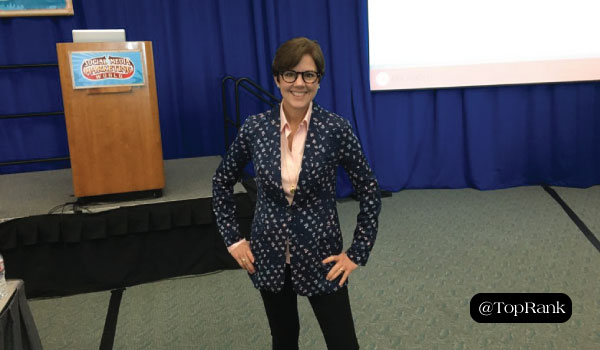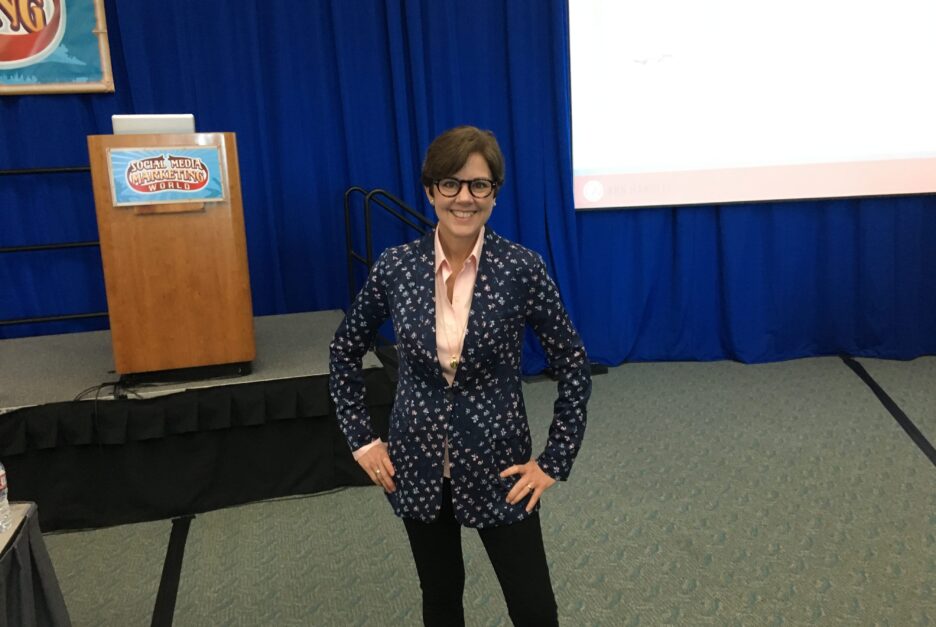
If you want to write amazing content like Ann Handley, don’t be a Dumbo.
Dumbo was convinced he could only fly while holding a “magic feather.” When he lost the feather mid-flight, he plummeted toward the ground. It wasn’t until he believed he could fly without the feather that he was able to take off again.
Too many would-be content creators are searching for their magic feather–the book, online course, or perfect antique typewriter that will make them a writer. And while they search, they can’t or won’t write.
So Ann began her session at Social Media Marketing World by asking us all to recite a pledge out loud:
“I don’t believe in unicorns, fairies, or Santa. There is no magic feather.”
Despite the slander against Mr. Claus (who I have on good authority is very real), it’s a crucial first step. You have to know that good writing is a learned skill, not something magically bestowed on those with the right talisman.
You can do it. You can get better at it.
Here are Ann Handley’s five tips for writing “ludicrously spectacular” content.
#1: It Starts with Not Writing
At least half of the writing process doesn’t look anything like writing. Now, you may be thinking, “frequently what I’m doing while I’m supposed to be writing is not writing.” That’s not quite what Ann means, though.
“Not writing” means being in idea-gathering mode all the time, when you’re out in the world, bingeing on Netflix, or just daydreaming at work. Writers should gather ideas like squirrels gather nuts–always on the lookout, never passing one up, and stashing them where we can get at them later.
The difference between a productive writing session and a frustrating hour staring at a blank screen is having a stash of ideas to go through. Whether you keep them in a notebook, or a service like Evernote or OneNote, commit to hoarding at least five ideas a day.
When you’re ready to write, snag an idea from your stash and, as Ann puts it, “explore the daylights out of it.” Use tools like BloomBerry, Board Reader, and Buzzsumo to see how people are talking about the idea, so you can develop your own approach.
#2: Write an Ugly First Draft
When you do start to write your first draft, silence your inner critic and focus on getting the words from your brain to the screen. Know that you will revise the work at least once–probably more–before you publish. It’s incredibly freeing to accept that your first draft will be bad. As Ann puts it, “You can’t write well without first writing spectacularly badly.”
That first draft doesn’t have to be a fully-fleshed out draft, either. It could be a list of points you want to cover, a really informal summary of the piece, or even something you dictate into your phone. The point is to give yourself something you can build on. It’s a giant leap from nothing to something–anything you do after that first leap will be easier. So whatever it takes to get something on the page, go for it.
After you finish your ugly first draft, let it rest for a while. Give your brain a little time off and let the piece sit. You’ll be better equipped to edit if you have some distance.
#3: Screw & Do
It’s not as salacious as it sounds: first, identify the ‘screw,’ the one key point for your reader that your whole piece revolves around. Second, do the editing you need to get to the screw as quickly and compellingly as possible.
How do you find your screw? Develop pathological empathy for your reader. Ann recommends the “so what?” process. Start with the statement you want to make, then imagine your reader shouting “SO WHAT?” Keep asking “SO WHAT?” and refining your message, and you will find the purest version of what you want to say, expressed in terms of benefit to the reader.
For the editing process, start with a self-edit by chainsaw. Ann says, “make every paragraph earn its keep.” In the first pass you’re trying to carve out huge chunks of writing that, while they may be very pretty or witty, aren’t serving your screw. Seek to create momentum for the reader by cutting out the junk that slows them down.
Then break it down to the sentence level. Edit with your scalpel, making sure each sentence is earning its keep. Edit for voice–when you read it out loud, does it sound like a person with a point of view wrote it? As Ann says, “If the label fell off, would they know it’s you?”
After the content is in fighting trim, then you can edit for grammar, formatting, all the small stuff. But the grammar should be the last consideration. There’s no point in repainting a condemned house. Get it structurally sound first.
#4: Write a Killer First Line
“Your reader is always looking for reasons NOT to read,” Ann says. You know it’s true–we’re always looking for the next distraction. A boring first line does your reader a favor; it gives them permission to move on.
Your first line needs to captivate the reader. Always lead with something that can capture attention. It could be a funny line, a wild statistic, or even just a strong point of view. Don’t be afraid to evoke an emotion, whether it’s amusement, wonder, or even fear.
#5: It’s All about the Voice
Your voice–or brand voice–can be a major differentiator in a sea of same-y content. Your voice should express:
- Who you are
- Why you do what you do
- What you are like to deal with
Which means, of course, you need to know the answer to these questions before you start.
Marketers are often encouraged to ask, “If your brand were a person, would you want to hang out with it?” When you’re writing brand content, you’re asking people to hang out with your brand. Not every brand needs to be the life of the party, but your voice should communicate why your brand is a worthy companion.
Take the Spectacular Writing Pledge
Even in the age of infographics and videos, good writing and great content excel. From landing pages to blog posts, eBooks to ad copy, let’s pledge to create ludicrously spectacular content.
Feel free to stand up wherever you are and repeat out loud Ann Handley’s pledge:
“I will collect & hoard 5 ideas a day. I will not hit backspace while writing a first draft. I will not go straight from writing to publishing. I will have pathological empathy for the reader. I will not sound like everyone else. And there ain’t no magic feather!”
And if you do stand up and say it out loud, please take a video and tag Ann @MarketingProfs when you post it.



